C/NUR 833: Quality Improvement Project to Reduce Falls in Nursing
VerifiedAdded on 2023/04/20
|13
|4031
|316
Report
AI Summary
This report details a quality improvement project implemented in a nursing home to reduce falls among residents. The project utilizes the Plan-Do-Study-Act (PDSA) cycle and focuses on staff education, post-fall huddles, and individualized care plans. The analysis covers the strengths and limitations of the model, including the importance of teamwork and the challenges posed by staff shortages. The initiative is grounded in principles of patient-centered care, harm reduction, and maximizing resident independence. The roles of various healthcare professionals, such as restorative care staff, physiotherapists, occupational therapists, nurses, and personal support workers, are outlined. The project achieved a 25% reduction in falls within six months, highlighting the effectiveness of the implemented strategies. The report also provides recommendations for further improvement and discusses the importance of ongoing evaluation and adaptation of fall prevention measures.
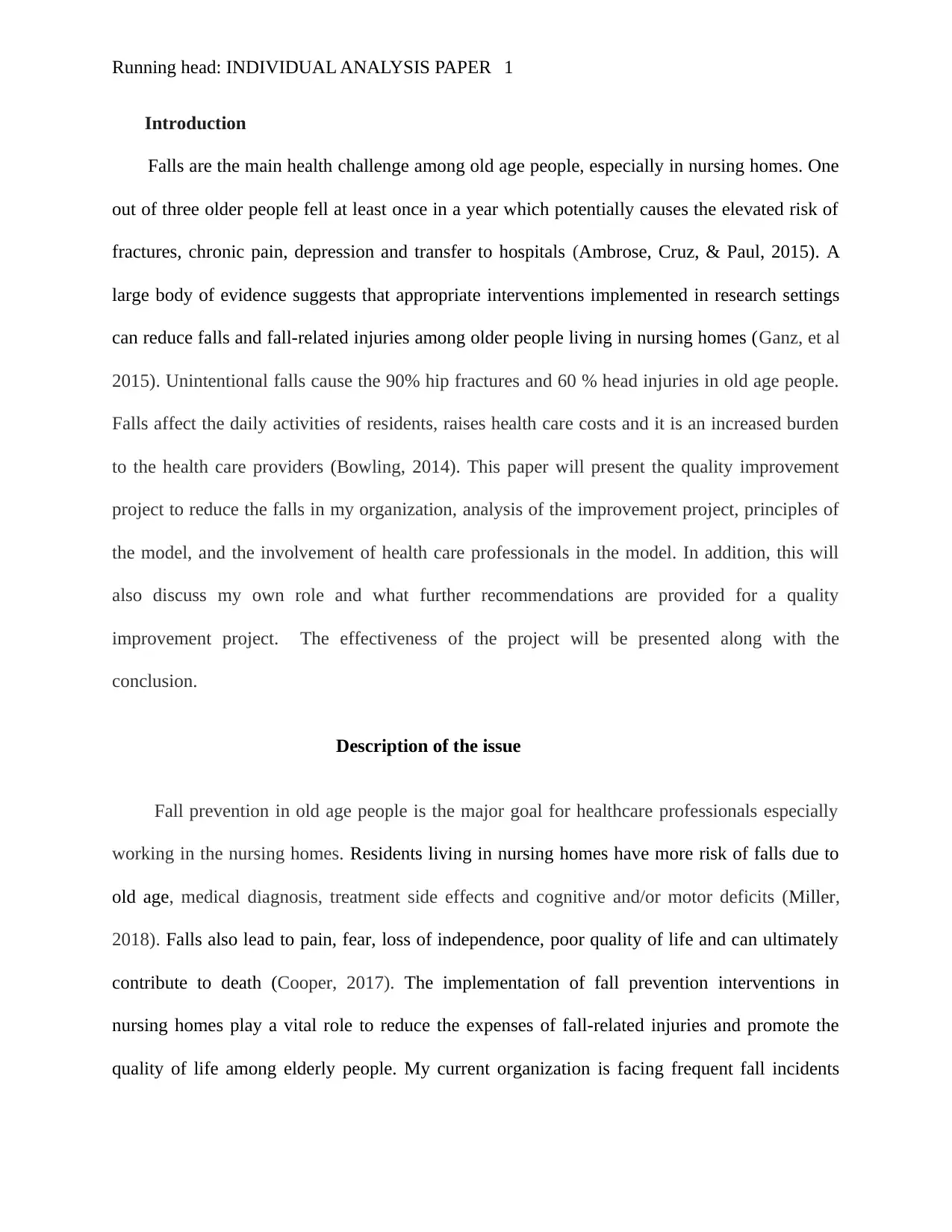
Running head: INDIVIDUAL ANALYSIS PAPER 1
Introduction
Falls are the main health challenge among old age people, especially in nursing homes. One
out of three older people fell at least once in a year which potentially causes the elevated risk of
fractures, chronic pain, depression and transfer to hospitals (Ambrose, Cruz, & Paul, 2015). A
large body of evidence suggests that appropriate interventions implemented in research settings
can reduce falls and fall-related injuries among older people living in nursing homes (Ganz, et al
2015). Unintentional falls cause the 90% hip fractures and 60 % head injuries in old age people.
Falls affect the daily activities of residents, raises health care costs and it is an increased burden
to the health care providers (Bowling, 2014). This paper will present the quality improvement
project to reduce the falls in my organization, analysis of the improvement project, principles of
the model, and the involvement of health care professionals in the model. In addition, this will
also discuss my own role and what further recommendations are provided for a quality
improvement project. The effectiveness of the project will be presented along with the
conclusion.
Description of the issue
Fall prevention in old age people is the major goal for healthcare professionals especially
working in the nursing homes. Residents living in nursing homes have more risk of falls due to
old age, medical diagnosis, treatment side effects and cognitive and/or motor deficits (Miller,
2018). Falls also lead to pain, fear, loss of independence, poor quality of life and can ultimately
contribute to death (Cooper, 2017). The implementation of fall prevention interventions in
nursing homes play a vital role to reduce the expenses of fall-related injuries and promote the
quality of life among elderly people. My current organization is facing frequent fall incidents
Introduction
Falls are the main health challenge among old age people, especially in nursing homes. One
out of three older people fell at least once in a year which potentially causes the elevated risk of
fractures, chronic pain, depression and transfer to hospitals (Ambrose, Cruz, & Paul, 2015). A
large body of evidence suggests that appropriate interventions implemented in research settings
can reduce falls and fall-related injuries among older people living in nursing homes (Ganz, et al
2015). Unintentional falls cause the 90% hip fractures and 60 % head injuries in old age people.
Falls affect the daily activities of residents, raises health care costs and it is an increased burden
to the health care providers (Bowling, 2014). This paper will present the quality improvement
project to reduce the falls in my organization, analysis of the improvement project, principles of
the model, and the involvement of health care professionals in the model. In addition, this will
also discuss my own role and what further recommendations are provided for a quality
improvement project. The effectiveness of the project will be presented along with the
conclusion.
Description of the issue
Fall prevention in old age people is the major goal for healthcare professionals especially
working in the nursing homes. Residents living in nursing homes have more risk of falls due to
old age, medical diagnosis, treatment side effects and cognitive and/or motor deficits (Miller,
2018). Falls also lead to pain, fear, loss of independence, poor quality of life and can ultimately
contribute to death (Cooper, 2017). The implementation of fall prevention interventions in
nursing homes play a vital role to reduce the expenses of fall-related injuries and promote the
quality of life among elderly people. My current organization is facing frequent fall incidents
Paraphrase This Document
Need a fresh take? Get an instant paraphrase of this document with our AI Paraphraser

FALL PREVENTION QUALITY IMPROVEMENT PROJECT 2
among residents which potentially affect the physical and psychological well-being of residents.
The mission of my organization is to provide quality care to its residents, interprofessional
collaboration, staff education and reducing the expenses due to falling-related injuries. The
Restorative care committee decided to initiate the quality improvement project to decrease the
number of falls among residents. The healthcare professionals worked together in a team and
followed the fall prevention strategies in their daily practices to achieve the same goal of fall
reduction and promote the well-being of residents (Duan & Zou 2017). The quality
improvement initiative was based on the fall prevention education and post-fall huddles to find
the root cause of falls. The purpose of this initiative was to minimize the falls from the current
number that is 75% to 50% within six months from October 01/2018 to March 31/2019
Quality Improvement Model
The Plan Do Study Act (PDSA) model for quality Improvement was used for the purpose to
reduce the falls in nursing home residents. The Plan Do Study Act (PDSA) cycles supported staff
involvement in approving, assessment and reflecting on the modifications was made to
accomplish the aim of reducing or minimizing the number of falls by 25%. The fall improvement
group involved health care team that included, the restorative care staff, assistant director of care
(ADOC), physiotherapist, occupational therapist, Physician, RNs and RPNs and personal support
workers. The Standards for completion of the fall risk assessment tool on new admissions, post
falls and upon a change in resident status was approved by the improvement group in the care
home (Cooper, 2017).
The implementation of the well-known interventions demonstrates the do within the PDSA
model. Speakers from outside organizations especially from RNAO were invited for further
among residents which potentially affect the physical and psychological well-being of residents.
The mission of my organization is to provide quality care to its residents, interprofessional
collaboration, staff education and reducing the expenses due to falling-related injuries. The
Restorative care committee decided to initiate the quality improvement project to decrease the
number of falls among residents. The healthcare professionals worked together in a team and
followed the fall prevention strategies in their daily practices to achieve the same goal of fall
reduction and promote the well-being of residents (Duan & Zou 2017). The quality
improvement initiative was based on the fall prevention education and post-fall huddles to find
the root cause of falls. The purpose of this initiative was to minimize the falls from the current
number that is 75% to 50% within six months from October 01/2018 to March 31/2019
Quality Improvement Model
The Plan Do Study Act (PDSA) model for quality Improvement was used for the purpose to
reduce the falls in nursing home residents. The Plan Do Study Act (PDSA) cycles supported staff
involvement in approving, assessment and reflecting on the modifications was made to
accomplish the aim of reducing or minimizing the number of falls by 25%. The fall improvement
group involved health care team that included, the restorative care staff, assistant director of care
(ADOC), physiotherapist, occupational therapist, Physician, RNs and RPNs and personal support
workers. The Standards for completion of the fall risk assessment tool on new admissions, post
falls and upon a change in resident status was approved by the improvement group in the care
home (Cooper, 2017).
The implementation of the well-known interventions demonstrates the do within the PDSA
model. Speakers from outside organizations especially from RNAO were invited for further
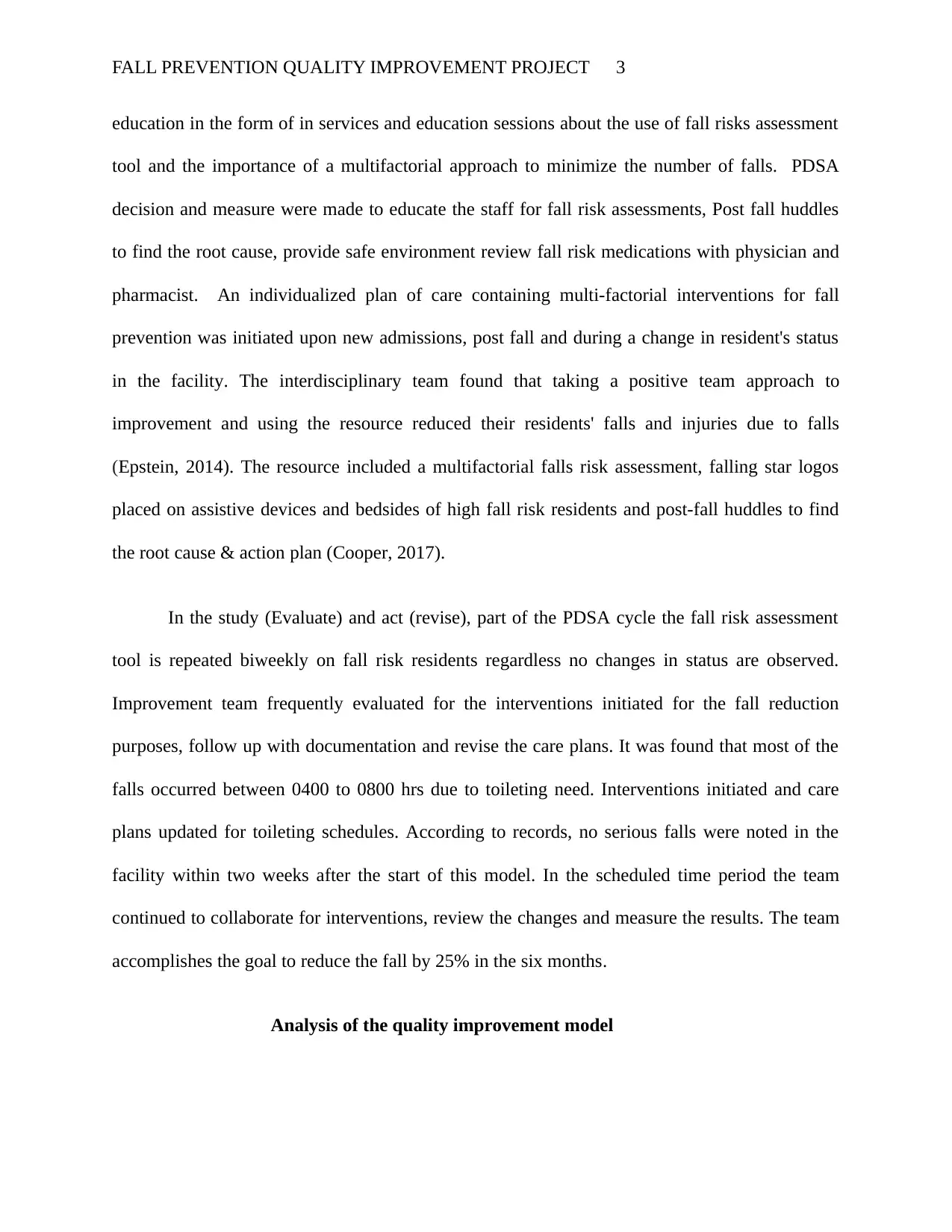
FALL PREVENTION QUALITY IMPROVEMENT PROJECT 3
education in the form of in services and education sessions about the use of fall risks assessment
tool and the importance of a multifactorial approach to minimize the number of falls. PDSA
decision and measure were made to educate the staff for fall risk assessments, Post fall huddles
to find the root cause, provide safe environment review fall risk medications with physician and
pharmacist. An individualized plan of care containing multi-factorial interventions for fall
prevention was initiated upon new admissions, post fall and during a change in resident's status
in the facility. The interdisciplinary team found that taking a positive team approach to
improvement and using the resource reduced their residents' falls and injuries due to falls
(Epstein, 2014). The resource included a multifactorial falls risk assessment, falling star logos
placed on assistive devices and bedsides of high fall risk residents and post-fall huddles to find
the root cause & action plan (Cooper, 2017).
In the study (Evaluate) and act (revise), part of the PDSA cycle the fall risk assessment
tool is repeated biweekly on fall risk residents regardless no changes in status are observed.
Improvement team frequently evaluated for the interventions initiated for the fall reduction
purposes, follow up with documentation and revise the care plans. It was found that most of the
falls occurred between 0400 to 0800 hrs due to toileting need. Interventions initiated and care
plans updated for toileting schedules. According to records, no serious falls were noted in the
facility within two weeks after the start of this model. In the scheduled time period the team
continued to collaborate for interventions, review the changes and measure the results. The team
accomplishes the goal to reduce the fall by 25% in the six months.
Analysis of the quality improvement model
education in the form of in services and education sessions about the use of fall risks assessment
tool and the importance of a multifactorial approach to minimize the number of falls. PDSA
decision and measure were made to educate the staff for fall risk assessments, Post fall huddles
to find the root cause, provide safe environment review fall risk medications with physician and
pharmacist. An individualized plan of care containing multi-factorial interventions for fall
prevention was initiated upon new admissions, post fall and during a change in resident's status
in the facility. The interdisciplinary team found that taking a positive team approach to
improvement and using the resource reduced their residents' falls and injuries due to falls
(Epstein, 2014). The resource included a multifactorial falls risk assessment, falling star logos
placed on assistive devices and bedsides of high fall risk residents and post-fall huddles to find
the root cause & action plan (Cooper, 2017).
In the study (Evaluate) and act (revise), part of the PDSA cycle the fall risk assessment
tool is repeated biweekly on fall risk residents regardless no changes in status are observed.
Improvement team frequently evaluated for the interventions initiated for the fall reduction
purposes, follow up with documentation and revise the care plans. It was found that most of the
falls occurred between 0400 to 0800 hrs due to toileting need. Interventions initiated and care
plans updated for toileting schedules. According to records, no serious falls were noted in the
facility within two weeks after the start of this model. In the scheduled time period the team
continued to collaborate for interventions, review the changes and measure the results. The team
accomplishes the goal to reduce the fall by 25% in the six months.
Analysis of the quality improvement model
⊘ This is a preview!⊘
Do you want full access?
Subscribe today to unlock all pages.

Trusted by 1+ million students worldwide

FALL PREVENTION QUALITY IMPROVEMENT PROJECT 4
A process is strictly highlighted in the fall prevention quality improvement model. The Plan-
Do-Study-Act (PDSA) cycle - is a tool which tests a change by developing a plan, carrying out
the test, observing and learning from the consequences of the tested change and determining
what modifications should be made to the test (Christoff, 2018)
The strengths of the quality improvement model are fall prevention education to staff,
patients and families for fall prevention interventions and post-fall huddles with the
interdisciplinary team to find the root cause. A specific cause of fall can be identified during
post-fall huddles with an interdisciplinary team because falls could happen due to multiple
factors like mobility, medications or change in status (Duan & Zou 2017).
Good teamwork and collaboration played a very important role in the success of this project.
Each member had a strong understanding of their role in the team and they created their
individualized fall prevention care plans according to their own perspectives. The success of this
project leads to a reduction of time spent on documentation. This was helpful to save the
residents from potentially serious injuries happening due to falls and maintaining their self-
independence (Cooper,2017).
Despite the success, some limitations were experienced. Shortage of staff was the biggest
limitation. Evidence-based fall reduction interventions were not properly implemented by health
care providers due to the shortage of staff and a heavy workload. Full time scheduled staff who
had the same assignments of residents was more aware of the fall risk factors. More falls occur
when sometimes full-time scheduled staff pulled to other places from their regular working units
or in a case when casual or part-time staff replace the full-time staff in their absence. Secondly,
improvement group found it very hard to meet the prediction measure because some senior staff
was resistant to completing the tools as they believed that falls were part of the aging process and
A process is strictly highlighted in the fall prevention quality improvement model. The Plan-
Do-Study-Act (PDSA) cycle - is a tool which tests a change by developing a plan, carrying out
the test, observing and learning from the consequences of the tested change and determining
what modifications should be made to the test (Christoff, 2018)
The strengths of the quality improvement model are fall prevention education to staff,
patients and families for fall prevention interventions and post-fall huddles with the
interdisciplinary team to find the root cause. A specific cause of fall can be identified during
post-fall huddles with an interdisciplinary team because falls could happen due to multiple
factors like mobility, medications or change in status (Duan & Zou 2017).
Good teamwork and collaboration played a very important role in the success of this project.
Each member had a strong understanding of their role in the team and they created their
individualized fall prevention care plans according to their own perspectives. The success of this
project leads to a reduction of time spent on documentation. This was helpful to save the
residents from potentially serious injuries happening due to falls and maintaining their self-
independence (Cooper,2017).
Despite the success, some limitations were experienced. Shortage of staff was the biggest
limitation. Evidence-based fall reduction interventions were not properly implemented by health
care providers due to the shortage of staff and a heavy workload. Full time scheduled staff who
had the same assignments of residents was more aware of the fall risk factors. More falls occur
when sometimes full-time scheduled staff pulled to other places from their regular working units
or in a case when casual or part-time staff replace the full-time staff in their absence. Secondly,
improvement group found it very hard to meet the prediction measure because some senior staff
was resistant to completing the tools as they believed that falls were part of the aging process and
Paraphrase This Document
Need a fresh take? Get an instant paraphrase of this document with our AI Paraphraser
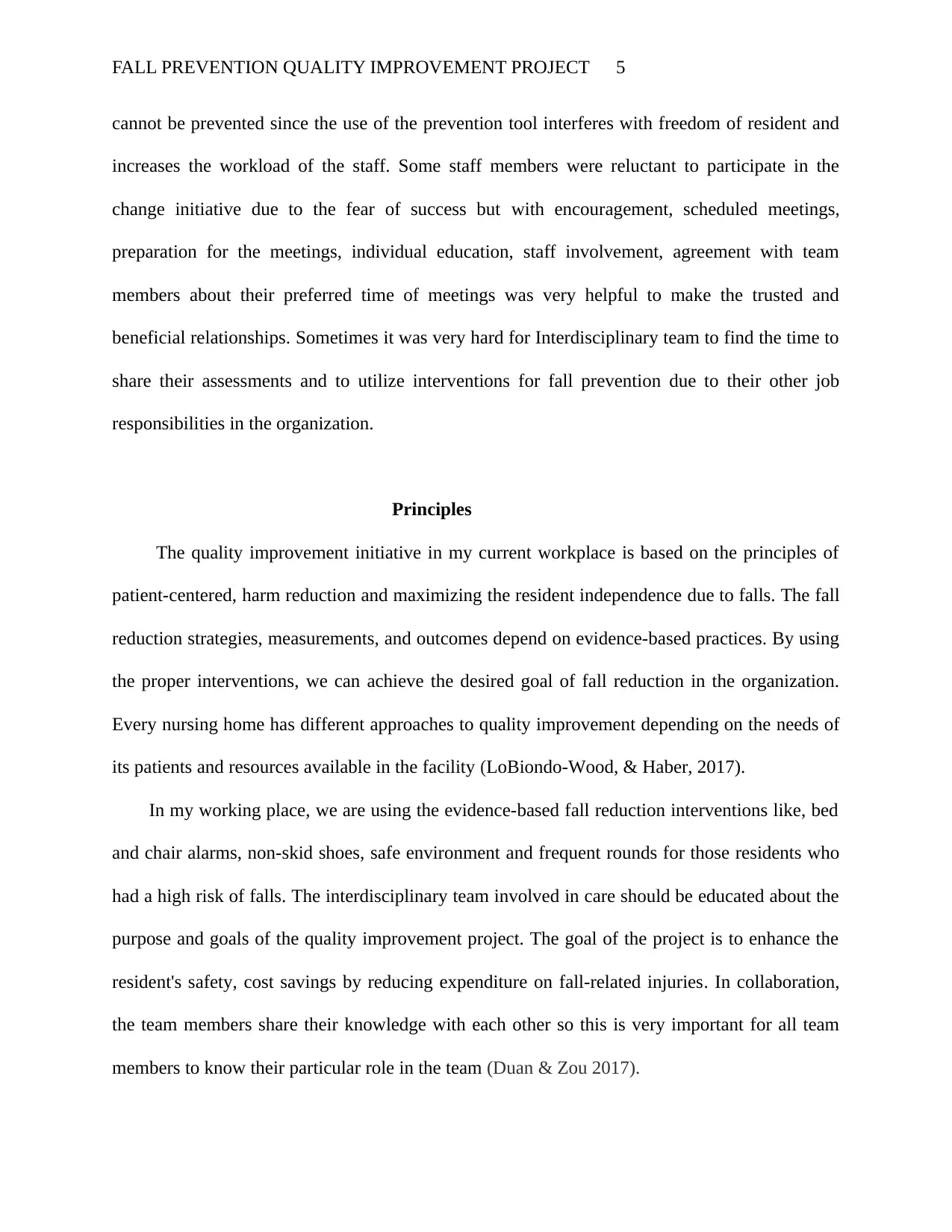
FALL PREVENTION QUALITY IMPROVEMENT PROJECT 5
cannot be prevented since the use of the prevention tool interferes with freedom of resident and
increases the workload of the staff. Some staff members were reluctant to participate in the
change initiative due to the fear of success but with encouragement, scheduled meetings,
preparation for the meetings, individual education, staff involvement, agreement with team
members about their preferred time of meetings was very helpful to make the trusted and
beneficial relationships. Sometimes it was very hard for Interdisciplinary team to find the time to
share their assessments and to utilize interventions for fall prevention due to their other job
responsibilities in the organization.
Principles
The quality improvement initiative in my current workplace is based on the principles of
patient-centered, harm reduction and maximizing the resident independence due to falls. The fall
reduction strategies, measurements, and outcomes depend on evidence-based practices. By using
the proper interventions, we can achieve the desired goal of fall reduction in the organization.
Every nursing home has different approaches to quality improvement depending on the needs of
its patients and resources available in the facility (LoBiondo-Wood, & Haber, 2017).
In my working place, we are using the evidence-based fall reduction interventions like, bed
and chair alarms, non-skid shoes, safe environment and frequent rounds for those residents who
had a high risk of falls. The interdisciplinary team involved in care should be educated about the
purpose and goals of the quality improvement project. The goal of the project is to enhance the
resident's safety, cost savings by reducing expenditure on fall-related injuries. In collaboration,
the team members share their knowledge with each other so this is very important for all team
members to know their particular role in the team (Duan & Zou 2017).
cannot be prevented since the use of the prevention tool interferes with freedom of resident and
increases the workload of the staff. Some staff members were reluctant to participate in the
change initiative due to the fear of success but with encouragement, scheduled meetings,
preparation for the meetings, individual education, staff involvement, agreement with team
members about their preferred time of meetings was very helpful to make the trusted and
beneficial relationships. Sometimes it was very hard for Interdisciplinary team to find the time to
share their assessments and to utilize interventions for fall prevention due to their other job
responsibilities in the organization.
Principles
The quality improvement initiative in my current workplace is based on the principles of
patient-centered, harm reduction and maximizing the resident independence due to falls. The fall
reduction strategies, measurements, and outcomes depend on evidence-based practices. By using
the proper interventions, we can achieve the desired goal of fall reduction in the organization.
Every nursing home has different approaches to quality improvement depending on the needs of
its patients and resources available in the facility (LoBiondo-Wood, & Haber, 2017).
In my working place, we are using the evidence-based fall reduction interventions like, bed
and chair alarms, non-skid shoes, safe environment and frequent rounds for those residents who
had a high risk of falls. The interdisciplinary team involved in care should be educated about the
purpose and goals of the quality improvement project. The goal of the project is to enhance the
resident's safety, cost savings by reducing expenditure on fall-related injuries. In collaboration,
the team members share their knowledge with each other so this is very important for all team
members to know their particular role in the team (Duan & Zou 2017).
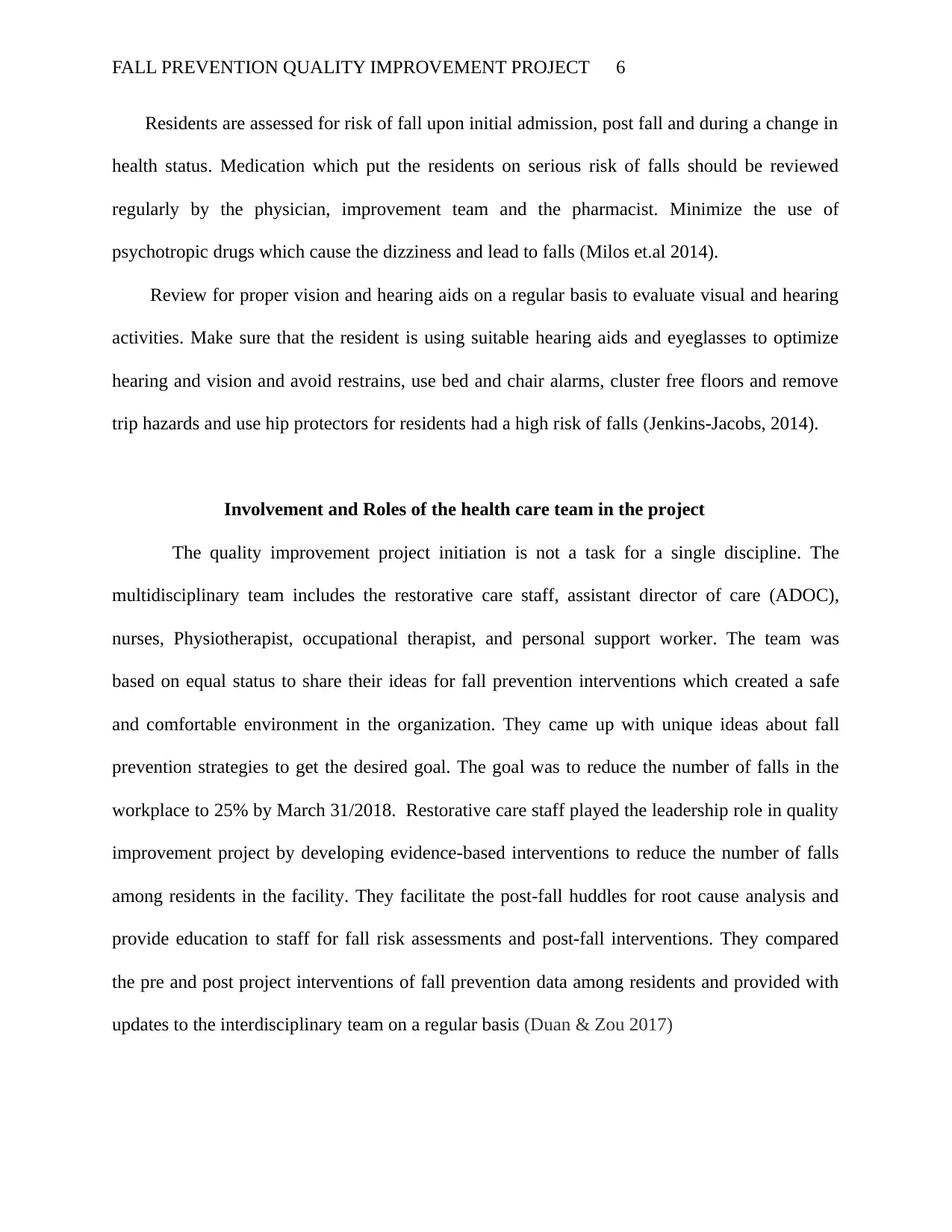
FALL PREVENTION QUALITY IMPROVEMENT PROJECT 6
Residents are assessed for risk of fall upon initial admission, post fall and during a change in
health status. Medication which put the residents on serious risk of falls should be reviewed
regularly by the physician, improvement team and the pharmacist. Minimize the use of
psychotropic drugs which cause the dizziness and lead to falls (Milos et.al 2014).
Review for proper vision and hearing aids on a regular basis to evaluate visual and hearing
activities. Make sure that the resident is using suitable hearing aids and eyeglasses to optimize
hearing and vision and avoid restrains, use bed and chair alarms, cluster free floors and remove
trip hazards and use hip protectors for residents had a high risk of falls (Jenkins-Jacobs, 2014).
Involvement and Roles of the health care team in the project
The quality improvement project initiation is not a task for a single discipline. The
multidisciplinary team includes the restorative care staff, assistant director of care (ADOC),
nurses, Physiotherapist, occupational therapist, and personal support worker. The team was
based on equal status to share their ideas for fall prevention interventions which created a safe
and comfortable environment in the organization. They came up with unique ideas about fall
prevention strategies to get the desired goal. The goal was to reduce the number of falls in the
workplace to 25% by March 31/2018. Restorative care staff played the leadership role in quality
improvement project by developing evidence-based interventions to reduce the number of falls
among residents in the facility. They facilitate the post-fall huddles for root cause analysis and
provide education to staff for fall risk assessments and post-fall interventions. They compared
the pre and post project interventions of fall prevention data among residents and provided with
updates to the interdisciplinary team on a regular basis (Duan & Zou 2017)
Residents are assessed for risk of fall upon initial admission, post fall and during a change in
health status. Medication which put the residents on serious risk of falls should be reviewed
regularly by the physician, improvement team and the pharmacist. Minimize the use of
psychotropic drugs which cause the dizziness and lead to falls (Milos et.al 2014).
Review for proper vision and hearing aids on a regular basis to evaluate visual and hearing
activities. Make sure that the resident is using suitable hearing aids and eyeglasses to optimize
hearing and vision and avoid restrains, use bed and chair alarms, cluster free floors and remove
trip hazards and use hip protectors for residents had a high risk of falls (Jenkins-Jacobs, 2014).
Involvement and Roles of the health care team in the project
The quality improvement project initiation is not a task for a single discipline. The
multidisciplinary team includes the restorative care staff, assistant director of care (ADOC),
nurses, Physiotherapist, occupational therapist, and personal support worker. The team was
based on equal status to share their ideas for fall prevention interventions which created a safe
and comfortable environment in the organization. They came up with unique ideas about fall
prevention strategies to get the desired goal. The goal was to reduce the number of falls in the
workplace to 25% by March 31/2018. Restorative care staff played the leadership role in quality
improvement project by developing evidence-based interventions to reduce the number of falls
among residents in the facility. They facilitate the post-fall huddles for root cause analysis and
provide education to staff for fall risk assessments and post-fall interventions. They compared
the pre and post project interventions of fall prevention data among residents and provided with
updates to the interdisciplinary team on a regular basis (Duan & Zou 2017)
⊘ This is a preview!⊘
Do you want full access?
Subscribe today to unlock all pages.

Trusted by 1+ million students worldwide
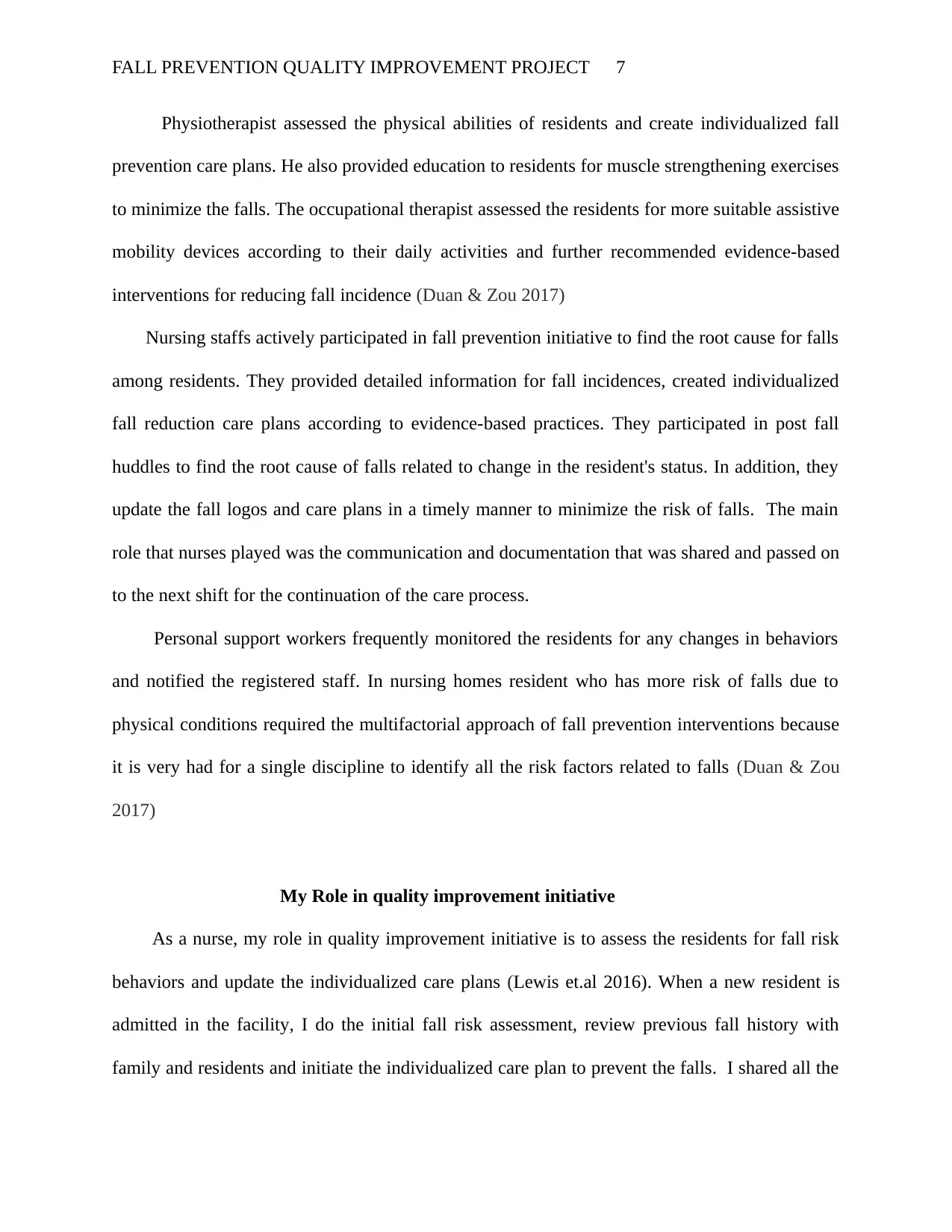
FALL PREVENTION QUALITY IMPROVEMENT PROJECT 7
Physiotherapist assessed the physical abilities of residents and create individualized fall
prevention care plans. He also provided education to residents for muscle strengthening exercises
to minimize the falls. The occupational therapist assessed the residents for more suitable assistive
mobility devices according to their daily activities and further recommended evidence-based
interventions for reducing fall incidence (Duan & Zou 2017)
Nursing staffs actively participated in fall prevention initiative to find the root cause for falls
among residents. They provided detailed information for fall incidences, created individualized
fall reduction care plans according to evidence-based practices. They participated in post fall
huddles to find the root cause of falls related to change in the resident's status. In addition, they
update the fall logos and care plans in a timely manner to minimize the risk of falls. The main
role that nurses played was the communication and documentation that was shared and passed on
to the next shift for the continuation of the care process.
Personal support workers frequently monitored the residents for any changes in behaviors
and notified the registered staff. In nursing homes resident who has more risk of falls due to
physical conditions required the multifactorial approach of fall prevention interventions because
it is very had for a single discipline to identify all the risk factors related to falls (Duan & Zou
2017)
My Role in quality improvement initiative
As a nurse, my role in quality improvement initiative is to assess the residents for fall risk
behaviors and update the individualized care plans (Lewis et.al 2016). When a new resident is
admitted in the facility, I do the initial fall risk assessment, review previous fall history with
family and residents and initiate the individualized care plan to prevent the falls. I shared all the
Physiotherapist assessed the physical abilities of residents and create individualized fall
prevention care plans. He also provided education to residents for muscle strengthening exercises
to minimize the falls. The occupational therapist assessed the residents for more suitable assistive
mobility devices according to their daily activities and further recommended evidence-based
interventions for reducing fall incidence (Duan & Zou 2017)
Nursing staffs actively participated in fall prevention initiative to find the root cause for falls
among residents. They provided detailed information for fall incidences, created individualized
fall reduction care plans according to evidence-based practices. They participated in post fall
huddles to find the root cause of falls related to change in the resident's status. In addition, they
update the fall logos and care plans in a timely manner to minimize the risk of falls. The main
role that nurses played was the communication and documentation that was shared and passed on
to the next shift for the continuation of the care process.
Personal support workers frequently monitored the residents for any changes in behaviors
and notified the registered staff. In nursing homes resident who has more risk of falls due to
physical conditions required the multifactorial approach of fall prevention interventions because
it is very had for a single discipline to identify all the risk factors related to falls (Duan & Zou
2017)
My Role in quality improvement initiative
As a nurse, my role in quality improvement initiative is to assess the residents for fall risk
behaviors and update the individualized care plans (Lewis et.al 2016). When a new resident is
admitted in the facility, I do the initial fall risk assessment, review previous fall history with
family and residents and initiate the individualized care plan to prevent the falls. I shared all the
Paraphrase This Document
Need a fresh take? Get an instant paraphrase of this document with our AI Paraphraser
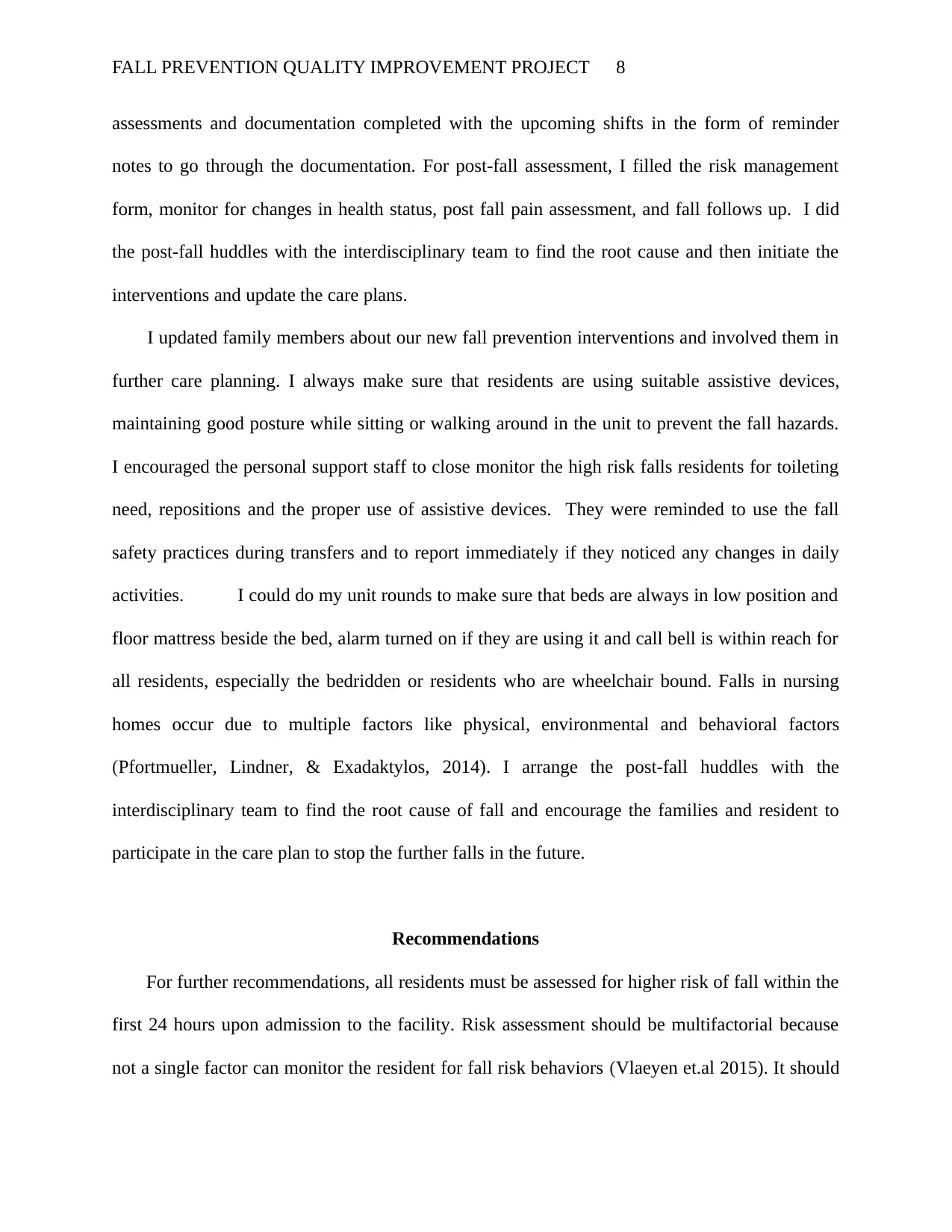
FALL PREVENTION QUALITY IMPROVEMENT PROJECT 8
assessments and documentation completed with the upcoming shifts in the form of reminder
notes to go through the documentation. For post-fall assessment, I filled the risk management
form, monitor for changes in health status, post fall pain assessment, and fall follows up. I did
the post-fall huddles with the interdisciplinary team to find the root cause and then initiate the
interventions and update the care plans.
I updated family members about our new fall prevention interventions and involved them in
further care planning. I always make sure that residents are using suitable assistive devices,
maintaining good posture while sitting or walking around in the unit to prevent the fall hazards.
I encouraged the personal support staff to close monitor the high risk falls residents for toileting
need, repositions and the proper use of assistive devices. They were reminded to use the fall
safety practices during transfers and to report immediately if they noticed any changes in daily
activities. I could do my unit rounds to make sure that beds are always in low position and
floor mattress beside the bed, alarm turned on if they are using it and call bell is within reach for
all residents, especially the bedridden or residents who are wheelchair bound. Falls in nursing
homes occur due to multiple factors like physical, environmental and behavioral factors
(Pfortmueller, Lindner, & Exadaktylos, 2014). I arrange the post-fall huddles with the
interdisciplinary team to find the root cause of fall and encourage the families and resident to
participate in the care plan to stop the further falls in the future.
Recommendations
For further recommendations, all residents must be assessed for higher risk of fall within the
first 24 hours upon admission to the facility. Risk assessment should be multifactorial because
not a single factor can monitor the resident for fall risk behaviors (Vlaeyen et.al 2015). It should
assessments and documentation completed with the upcoming shifts in the form of reminder
notes to go through the documentation. For post-fall assessment, I filled the risk management
form, monitor for changes in health status, post fall pain assessment, and fall follows up. I did
the post-fall huddles with the interdisciplinary team to find the root cause and then initiate the
interventions and update the care plans.
I updated family members about our new fall prevention interventions and involved them in
further care planning. I always make sure that residents are using suitable assistive devices,
maintaining good posture while sitting or walking around in the unit to prevent the fall hazards.
I encouraged the personal support staff to close monitor the high risk falls residents for toileting
need, repositions and the proper use of assistive devices. They were reminded to use the fall
safety practices during transfers and to report immediately if they noticed any changes in daily
activities. I could do my unit rounds to make sure that beds are always in low position and
floor mattress beside the bed, alarm turned on if they are using it and call bell is within reach for
all residents, especially the bedridden or residents who are wheelchair bound. Falls in nursing
homes occur due to multiple factors like physical, environmental and behavioral factors
(Pfortmueller, Lindner, & Exadaktylos, 2014). I arrange the post-fall huddles with the
interdisciplinary team to find the root cause of fall and encourage the families and resident to
participate in the care plan to stop the further falls in the future.
Recommendations
For further recommendations, all residents must be assessed for higher risk of fall within the
first 24 hours upon admission to the facility. Risk assessment should be multifactorial because
not a single factor can monitor the resident for fall risk behaviors (Vlaeyen et.al 2015). It should
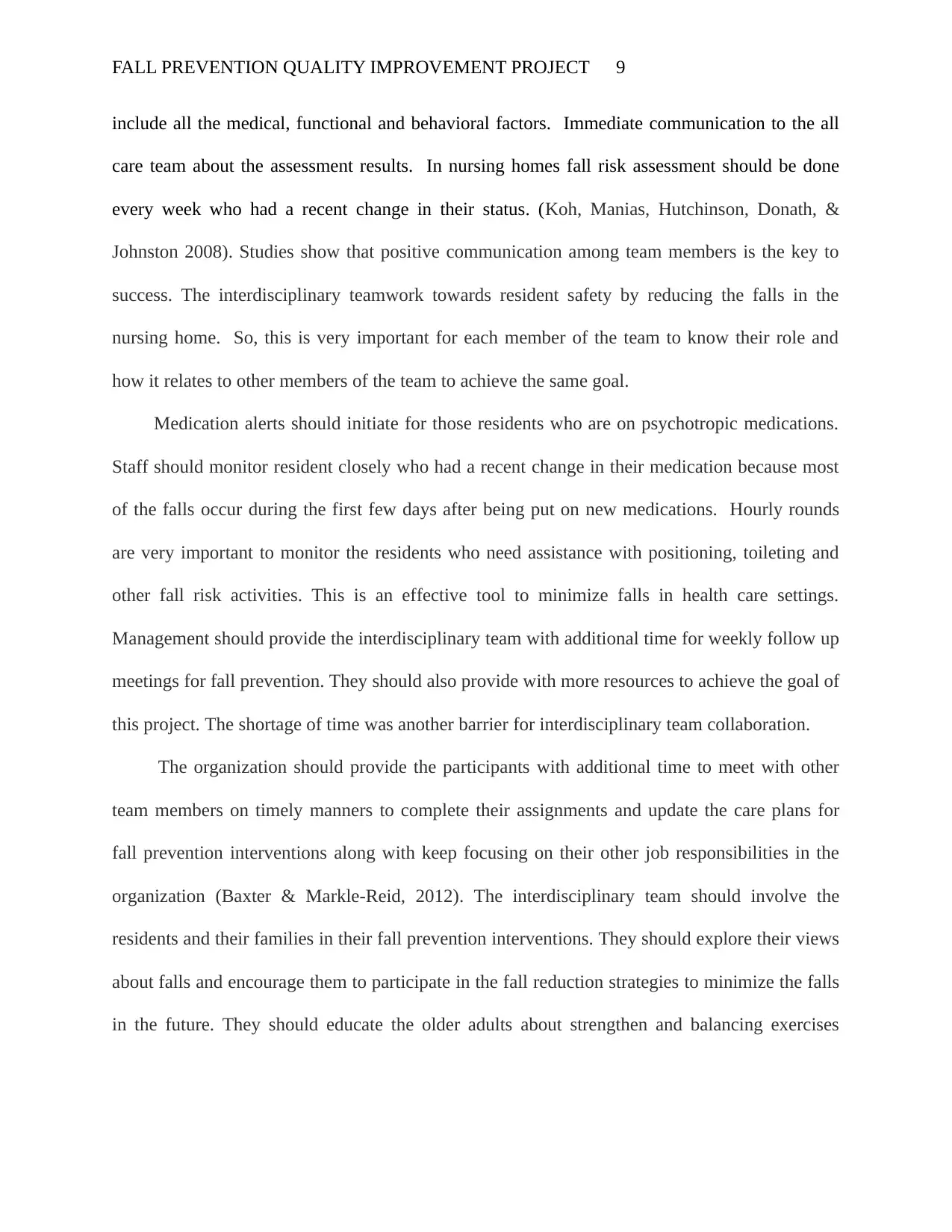
FALL PREVENTION QUALITY IMPROVEMENT PROJECT 9
include all the medical, functional and behavioral factors. Immediate communication to the all
care team about the assessment results. In nursing homes fall risk assessment should be done
every week who had a recent change in their status. (Koh, Manias, Hutchinson, Donath, &
Johnston 2008). Studies show that positive communication among team members is the key to
success. The interdisciplinary teamwork towards resident safety by reducing the falls in the
nursing home. So, this is very important for each member of the team to know their role and
how it relates to other members of the team to achieve the same goal.
Medication alerts should initiate for those residents who are on psychotropic medications.
Staff should monitor resident closely who had a recent change in their medication because most
of the falls occur during the first few days after being put on new medications. Hourly rounds
are very important to monitor the residents who need assistance with positioning, toileting and
other fall risk activities. This is an effective tool to minimize falls in health care settings.
Management should provide the interdisciplinary team with additional time for weekly follow up
meetings for fall prevention. They should also provide with more resources to achieve the goal of
this project. The shortage of time was another barrier for interdisciplinary team collaboration.
The organization should provide the participants with additional time to meet with other
team members on timely manners to complete their assignments and update the care plans for
fall prevention interventions along with keep focusing on their other job responsibilities in the
organization (Baxter & Markle-Reid, 2012). The interdisciplinary team should involve the
residents and their families in their fall prevention interventions. They should explore their views
about falls and encourage them to participate in the fall reduction strategies to minimize the falls
in the future. They should educate the older adults about strengthen and balancing exercises
include all the medical, functional and behavioral factors. Immediate communication to the all
care team about the assessment results. In nursing homes fall risk assessment should be done
every week who had a recent change in their status. (Koh, Manias, Hutchinson, Donath, &
Johnston 2008). Studies show that positive communication among team members is the key to
success. The interdisciplinary teamwork towards resident safety by reducing the falls in the
nursing home. So, this is very important for each member of the team to know their role and
how it relates to other members of the team to achieve the same goal.
Medication alerts should initiate for those residents who are on psychotropic medications.
Staff should monitor resident closely who had a recent change in their medication because most
of the falls occur during the first few days after being put on new medications. Hourly rounds
are very important to monitor the residents who need assistance with positioning, toileting and
other fall risk activities. This is an effective tool to minimize falls in health care settings.
Management should provide the interdisciplinary team with additional time for weekly follow up
meetings for fall prevention. They should also provide with more resources to achieve the goal of
this project. The shortage of time was another barrier for interdisciplinary team collaboration.
The organization should provide the participants with additional time to meet with other
team members on timely manners to complete their assignments and update the care plans for
fall prevention interventions along with keep focusing on their other job responsibilities in the
organization (Baxter & Markle-Reid, 2012). The interdisciplinary team should involve the
residents and their families in their fall prevention interventions. They should explore their views
about falls and encourage them to participate in the fall reduction strategies to minimize the falls
in the future. They should educate the older adults about strengthen and balancing exercises
⊘ This is a preview!⊘
Do you want full access?
Subscribe today to unlock all pages.

Trusted by 1+ million students worldwide
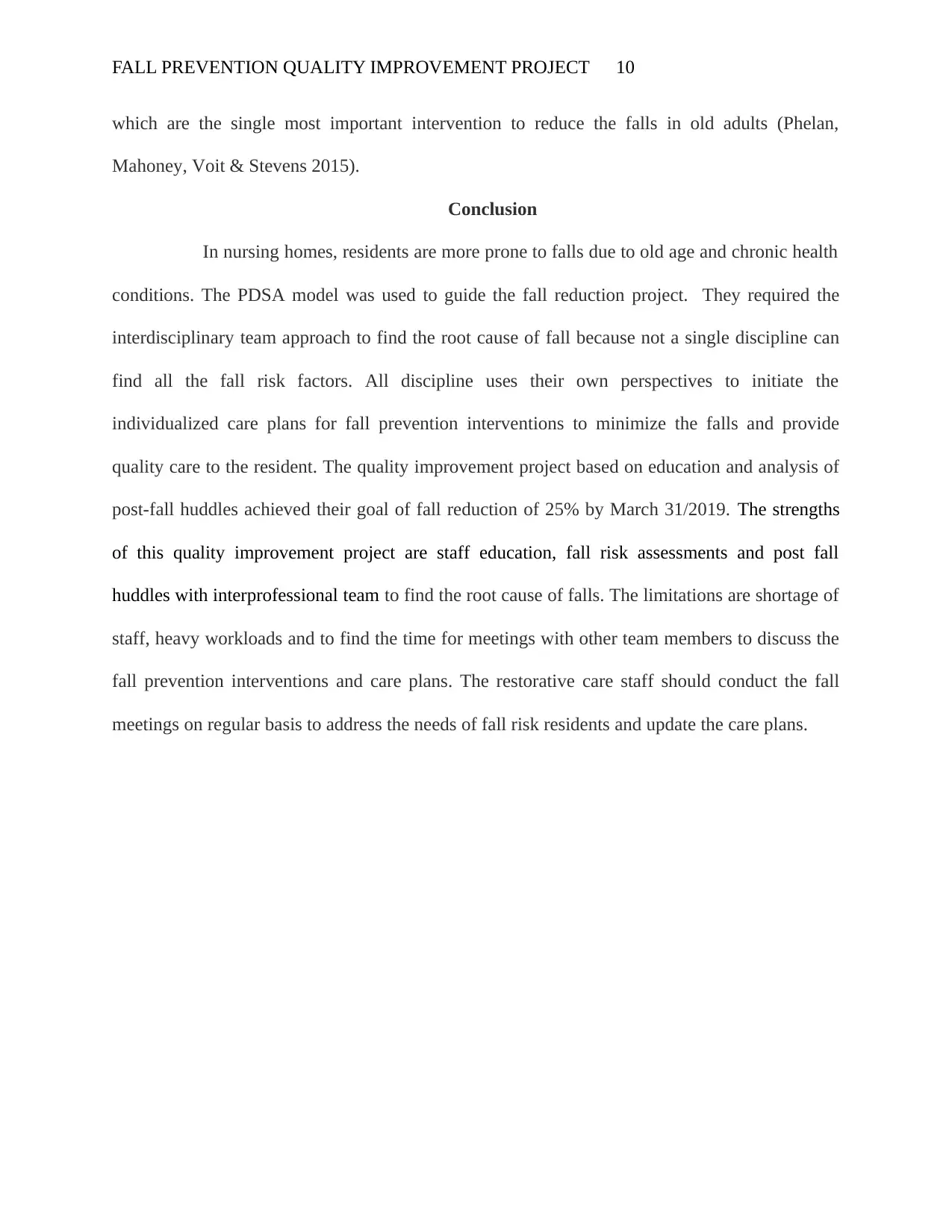
FALL PREVENTION QUALITY IMPROVEMENT PROJECT 10
which are the single most important intervention to reduce the falls in old adults (Phelan,
Mahoney, Voit & Stevens 2015).
Conclusion
In nursing homes, residents are more prone to falls due to old age and chronic health
conditions. The PDSA model was used to guide the fall reduction project. They required the
interdisciplinary team approach to find the root cause of fall because not a single discipline can
find all the fall risk factors. All discipline uses their own perspectives to initiate the
individualized care plans for fall prevention interventions to minimize the falls and provide
quality care to the resident. The quality improvement project based on education and analysis of
post-fall huddles achieved their goal of fall reduction of 25% by March 31/2019. The strengths
of this quality improvement project are staff education, fall risk assessments and post fall
huddles with interprofessional team to find the root cause of falls. The limitations are shortage of
staff, heavy workloads and to find the time for meetings with other team members to discuss the
fall prevention interventions and care plans. The restorative care staff should conduct the fall
meetings on regular basis to address the needs of fall risk residents and update the care plans.
which are the single most important intervention to reduce the falls in old adults (Phelan,
Mahoney, Voit & Stevens 2015).
Conclusion
In nursing homes, residents are more prone to falls due to old age and chronic health
conditions. The PDSA model was used to guide the fall reduction project. They required the
interdisciplinary team approach to find the root cause of fall because not a single discipline can
find all the fall risk factors. All discipline uses their own perspectives to initiate the
individualized care plans for fall prevention interventions to minimize the falls and provide
quality care to the resident. The quality improvement project based on education and analysis of
post-fall huddles achieved their goal of fall reduction of 25% by March 31/2019. The strengths
of this quality improvement project are staff education, fall risk assessments and post fall
huddles with interprofessional team to find the root cause of falls. The limitations are shortage of
staff, heavy workloads and to find the time for meetings with other team members to discuss the
fall prevention interventions and care plans. The restorative care staff should conduct the fall
meetings on regular basis to address the needs of fall risk residents and update the care plans.
Paraphrase This Document
Need a fresh take? Get an instant paraphrase of this document with our AI Paraphraser
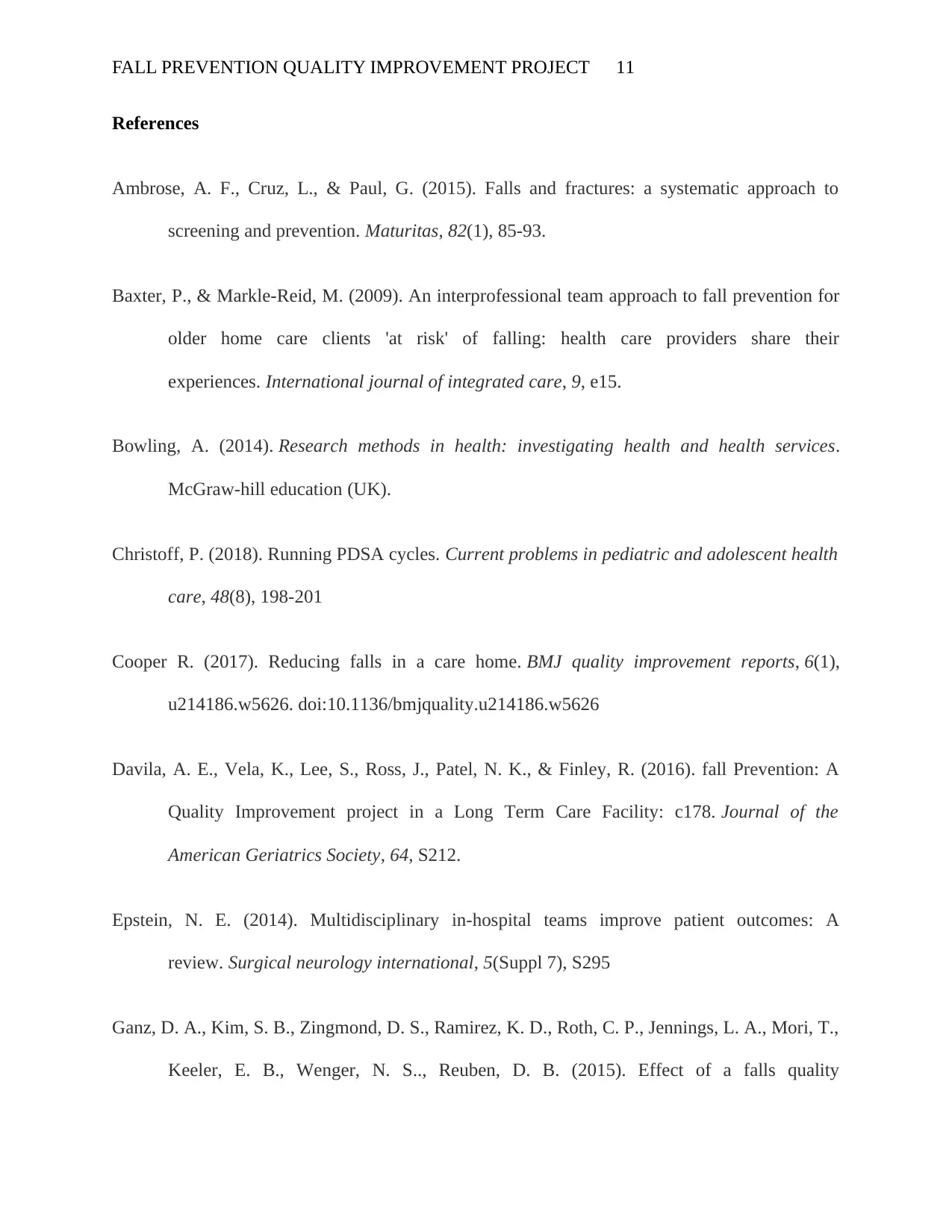
FALL PREVENTION QUALITY IMPROVEMENT PROJECT 11
References
Ambrose, A. F., Cruz, L., & Paul, G. (2015). Falls and fractures: a systematic approach to
screening and prevention. Maturitas, 82(1), 85-93.
Baxter, P., & Markle-Reid, M. (2009). An interprofessional team approach to fall prevention for
older home care clients 'at risk' of falling: health care providers share their
experiences. International journal of integrated care, 9, e15.
Bowling, A. (2014). Research methods in health: investigating health and health services.
McGraw-hill education (UK).
Christoff, P. (2018). Running PDSA cycles. Current problems in pediatric and adolescent health
care, 48(8), 198-201
Cooper R. (2017). Reducing falls in a care home. BMJ quality improvement reports, 6(1),
u214186.w5626. doi:10.1136/bmjquality.u214186.w5626
Davila, A. E., Vela, K., Lee, S., Ross, J., Patel, N. K., & Finley, R. (2016). fall Prevention: A
Quality Improvement project in a Long Term Care Facility: c178. Journal of the
American Geriatrics Society, 64, S212.
Epstein, N. E. (2014). Multidisciplinary in-hospital teams improve patient outcomes: A
review. Surgical neurology international, 5(Suppl 7), S295
Ganz, D. A., Kim, S. B., Zingmond, D. S., Ramirez, K. D., Roth, C. P., Jennings, L. A., Mori, T.,
Keeler, E. B., Wenger, N. S.., Reuben, D. B. (2015). Effect of a falls quality
References
Ambrose, A. F., Cruz, L., & Paul, G. (2015). Falls and fractures: a systematic approach to
screening and prevention. Maturitas, 82(1), 85-93.
Baxter, P., & Markle-Reid, M. (2009). An interprofessional team approach to fall prevention for
older home care clients 'at risk' of falling: health care providers share their
experiences. International journal of integrated care, 9, e15.
Bowling, A. (2014). Research methods in health: investigating health and health services.
McGraw-hill education (UK).
Christoff, P. (2018). Running PDSA cycles. Current problems in pediatric and adolescent health
care, 48(8), 198-201
Cooper R. (2017). Reducing falls in a care home. BMJ quality improvement reports, 6(1),
u214186.w5626. doi:10.1136/bmjquality.u214186.w5626
Davila, A. E., Vela, K., Lee, S., Ross, J., Patel, N. K., & Finley, R. (2016). fall Prevention: A
Quality Improvement project in a Long Term Care Facility: c178. Journal of the
American Geriatrics Society, 64, S212.
Epstein, N. E. (2014). Multidisciplinary in-hospital teams improve patient outcomes: A
review. Surgical neurology international, 5(Suppl 7), S295
Ganz, D. A., Kim, S. B., Zingmond, D. S., Ramirez, K. D., Roth, C. P., Jennings, L. A., Mori, T.,
Keeler, E. B., Wenger, N. S.., Reuben, D. B. (2015). Effect of a falls quality
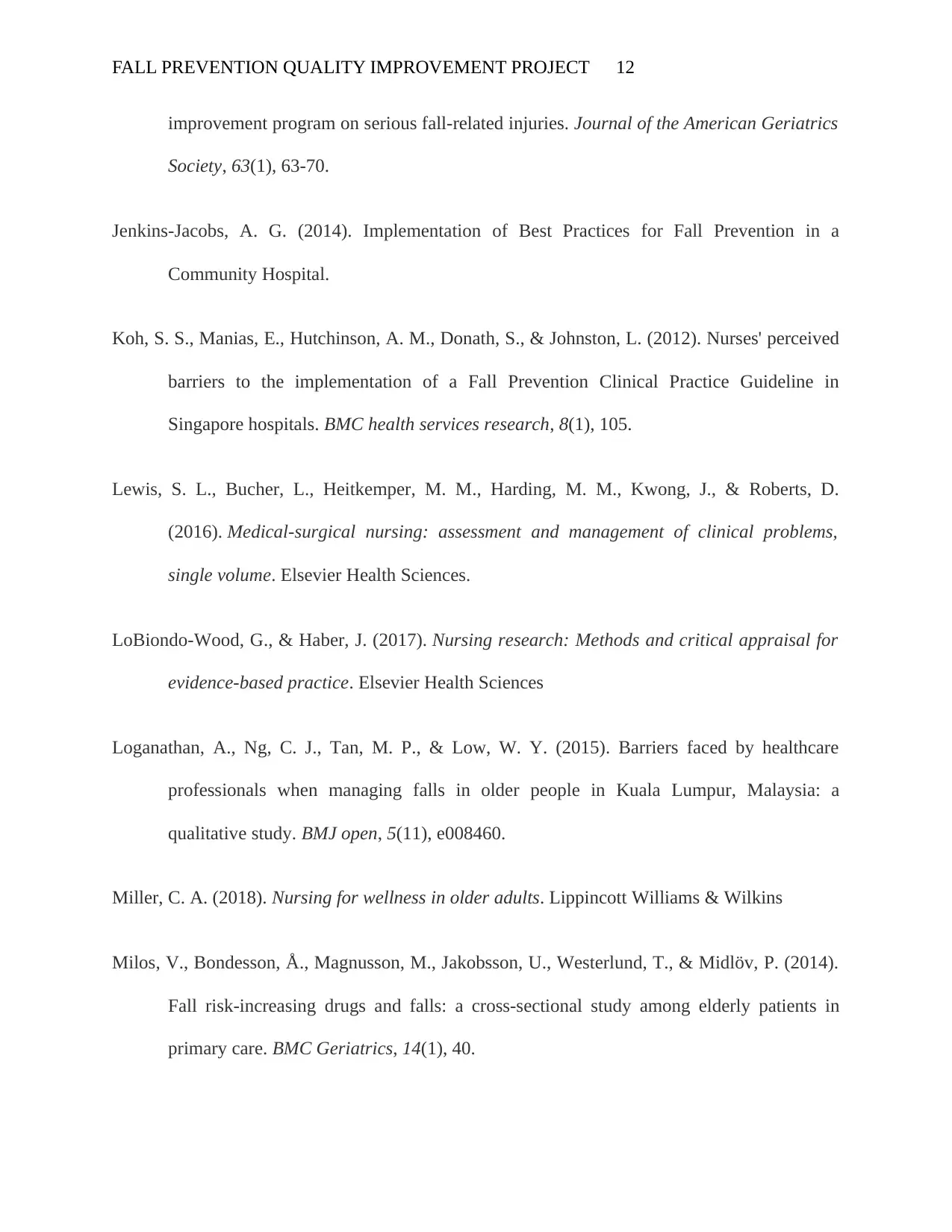
FALL PREVENTION QUALITY IMPROVEMENT PROJECT 12
improvement program on serious fall-related injuries. Journal of the American Geriatrics
Society, 63(1), 63-70.
Jenkins-Jacobs, A. G. (2014). Implementation of Best Practices for Fall Prevention in a
Community Hospital.
Koh, S. S., Manias, E., Hutchinson, A. M., Donath, S., & Johnston, L. (2012). Nurses' perceived
barriers to the implementation of a Fall Prevention Clinical Practice Guideline in
Singapore hospitals. BMC health services research, 8(1), 105.
Lewis, S. L., Bucher, L., Heitkemper, M. M., Harding, M. M., Kwong, J., & Roberts, D.
(2016). Medical-surgical nursing: assessment and management of clinical problems,
single volume. Elsevier Health Sciences.
LoBiondo-Wood, G., & Haber, J. (2017). Nursing research: Methods and critical appraisal for
evidence-based practice. Elsevier Health Sciences
Loganathan, A., Ng, C. J., Tan, M. P., & Low, W. Y. (2015). Barriers faced by healthcare
professionals when managing falls in older people in Kuala Lumpur, Malaysia: a
qualitative study. BMJ open, 5(11), e008460.
Miller, C. A. (2018). Nursing for wellness in older adults. Lippincott Williams & Wilkins
Milos, V., Bondesson, Å., Magnusson, M., Jakobsson, U., Westerlund, T., & Midlöv, P. (2014).
Fall risk-increasing drugs and falls: a cross-sectional study among elderly patients in
primary care. BMC Geriatrics, 14(1), 40.
improvement program on serious fall-related injuries. Journal of the American Geriatrics
Society, 63(1), 63-70.
Jenkins-Jacobs, A. G. (2014). Implementation of Best Practices for Fall Prevention in a
Community Hospital.
Koh, S. S., Manias, E., Hutchinson, A. M., Donath, S., & Johnston, L. (2012). Nurses' perceived
barriers to the implementation of a Fall Prevention Clinical Practice Guideline in
Singapore hospitals. BMC health services research, 8(1), 105.
Lewis, S. L., Bucher, L., Heitkemper, M. M., Harding, M. M., Kwong, J., & Roberts, D.
(2016). Medical-surgical nursing: assessment and management of clinical problems,
single volume. Elsevier Health Sciences.
LoBiondo-Wood, G., & Haber, J. (2017). Nursing research: Methods and critical appraisal for
evidence-based practice. Elsevier Health Sciences
Loganathan, A., Ng, C. J., Tan, M. P., & Low, W. Y. (2015). Barriers faced by healthcare
professionals when managing falls in older people in Kuala Lumpur, Malaysia: a
qualitative study. BMJ open, 5(11), e008460.
Miller, C. A. (2018). Nursing for wellness in older adults. Lippincott Williams & Wilkins
Milos, V., Bondesson, Å., Magnusson, M., Jakobsson, U., Westerlund, T., & Midlöv, P. (2014).
Fall risk-increasing drugs and falls: a cross-sectional study among elderly patients in
primary care. BMC Geriatrics, 14(1), 40.
⊘ This is a preview!⊘
Do you want full access?
Subscribe today to unlock all pages.

Trusted by 1+ million students worldwide
1 out of 13
Related Documents
Your All-in-One AI-Powered Toolkit for Academic Success.
+13062052269
info@desklib.com
Available 24*7 on WhatsApp / Email
![[object Object]](/_next/static/media/star-bottom.7253800d.svg)
Unlock your academic potential
Copyright © 2020–2025 A2Z Services. All Rights Reserved. Developed and managed by ZUCOL.





